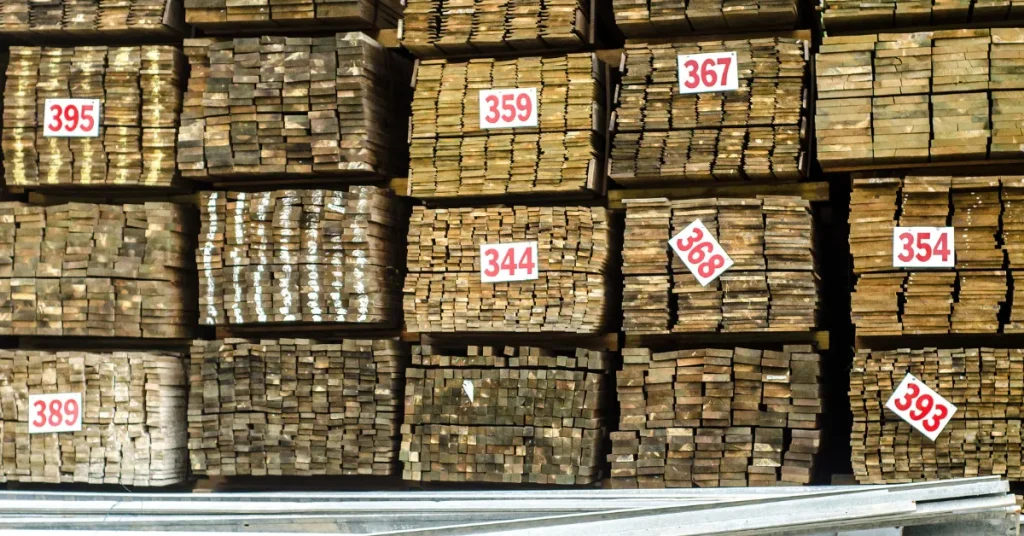A standard 1×6 board is actually 0.75 inches thick. It typically measures 5.5 inches in width.
Understanding the true dimensions of lumber is crucial for any construction project, DIY task, or when discussing specifications with contractors.
The ‘1×6’ nomenclature comes from the board’s nominal size before it’s finished – this sizing convention can often be confusing for those new to woodworking or construction.
Given the importance of precision in building, knowing that a 1×6 is not a full inch thick is essential for the accuracy of your project.
Whether you’re crafting a custom piece of furniture or framing a house, consider this discrepancy in size when planning to ensure all components fit together seamlessly.
Always check the actual measurements to avoid any potential problems that can arise from these nominal versus actual dimensions.

The Misnomer Of Lumber Sizes
Shopping for lumber might seem straightforward, yet there’s a peculiar twist to it. When you pick a 1×6 board, you’re not getting the full story in its size.
This common confusion stems from a traditional method of naming lumber sizes that doesn’t match their actual dimensions. Understanding this discrepancy helps in choosing the right wood for your project.
Actual Vs Nominal Measurements
What you see is not always what you get with lumber sizes. A ‘1×6’ board is named based on its nominal size.
This is the size of the wood when it is first cut, before being dried and planed. The actual size, which is its true thickness and width, is smaller.
The actual size of a ‘1×6’ can be:
- 3/4 inch thick
- 5 1/2 inches wide
This size difference is key for builders and DIY enthusiasts. Always check a lumber’s actual measurements before starting your task.
History Behind Lumber Naming Conventions
The tradition of lumber naming has deep roots. When sawmills first started, rough-cut lumber would measure true to its named dimensions. As the wood industry evolved, so did the processing steps.
Wood is now dried and planed to create a smooth finish. These processes shrink the wood from its original rough-cut size. Yet, the historical nominal names stayed the same, leading to the sizing confusion we face today.
| Nominal Size (inches) | Actual Size (inches) |
| 1×6 | 3/4 x 5 1/2 |
Grasp these lumber quirks, and your next project won’t face unexpected hitches.
Measuring Up The 1×6
When we talk about wood sizes, precision matters. A 1X6 board is common in construction and woodworking projects.
Yet, its name can mislead many. Let’s unravel the actual dimensions of a 1X6 board and explore why it doesn’t measure up exactly as you would expect.
Actual Dimensions Of A 1×6 Board
Understanding lumber sizes can be confusing. The name 1X6 suggests a board one inch thick and six inches wide.
Reality paints a different picture. Nominal measurements don’t match actual dimensions. This discrepancy exists because of how lumber is processed.
| Nominal Size | Actual Size (Inches) | Actual Size (Millimeters) |
| 1X6 | 3/4″ x 5 1/2″ | 19 x 140 |
| 1X8 | 3/4″ x 7 1/4″ | 19 x 184 |
The table above shows how a 1X6 is actually smaller. Its true thickness is 3/4 inch, not the full inch. The width is 5 1/2 inches, not six. Use this knowledge for accurate project planning.
Why 1x6s Are Not Truly One By Six
Why don’t these boards measure up? The reasoning is simple. Lumber is cut to size when still green. It then goes through a drying process.
This results in shrinkage. After drying, the boards get planed smooth. This reduces size further.
- Nominal sizes are the rough-cut measurements.
- Actual sizes are the final, smaller dimensions after drying and planing.
This difference is vital for designers, carpenters, and DIY enthusiasts. Always double-check actual sizes before making a purchase. It will save time, material, and frustration.
Factors Influencing Lumber Size

Understanding how lumber such as a 1X6 is sized is crucial when tackling a project. Yet, it’s not as simple as measuring the board’s width and length.
Several factors can affect the actual dimensions, including the two key elements we’ll explore: moisture content and milling processes.
Impact Of Moisture Content On Thickness
Moisture content plays a significant role in the size of lumber. When trees are first cut, the wood is known as “green” and contains a high amount of moisture.
As the wood dries, it shrinks. A 1X6, for instance, starts thicker and shrinks to its final size.
- Green lumber is thicker due to moisture.
- As wood dries, it loses moisture and shrinks.
- The final thickness depends on the level of dryness.
How Milling Affects Final Dimensions
The milling process also influences lumber dimensions. Mills cut wood into large rough sizes and later trim it down. This trimming allows the mill to remove imperfections and results in a uniform size.
- Rough cutting: Lumber is cut into oversized pieces.
- Trimming: Mills remove imperfections.
- Final size: The 1X6 reaches its standard dimensions.
Understanding these factors is essential for anyone using lumber to ensure their project pieces fit together perfectly.
Practical Implications In Construction
Understanding the true thickness of lumber, like a 1×6, is crucial in construction. This actual size can differ from the nominal dimensions which are typically used in blueprints. Knowing these specifics ensures structures are built accurately and stand the test of time.
Choosing The Right Lumber For Your Project
When you select wood for construction, size matters.
A 1×6 board’s actual thickness is not exactly one inch. It’s usually 3/4 inch thick.
The width can also be misleading. Instead of 6 inches, it’s more commonly 5.5 inches.
These details ensure you buy enough material for your project. Always measure lumber before purchase.
Remember: Lumber is labeled by its nominal size, not actual size.
Adjusting Blueprints To Actual Lumber Sizes
Blueprints don’t always reflect lumber’s true size.
Measure your materials.
Compare these to your plan dimensions.
If your lumber is smaller, adjust the design accordingly.
Use this simple chart for quick reference:
| Nominal Size | Actual Thickness | Actual Width |
| 1×6 | 3/4″ | 5.5″ |
Update your plans to ensure pieces fit. This avoids gaps in your build.
Prioritize accuracy for a polished end result.
Beyond The 1×6: Other Lumber Anomalies
Lumber, like the common 1×6 board, often brings surprises. Boards have names that suggest one size but are actually another.
It’s vital for DIY enthusiasts and professionals alike to understand these peculiarities. Let’s dive into the world of lumber, beyond the 1×6, to unravel some of these sizing quirks.
Interpreting Lumber Labels Correctly

Understanding lumber labels is key to getting the size you need. When you see a size like 1×6, consider the ‘nominal size’—the name of the board before planing. The ‘actual size’ is the board’s true dimensions. Here’s a tip:
| Nominal Size | Actual Size |
| 1×6 | 0.75 x 5.5 inches |
| 2×4 | 1.5 x 3.5 inches |
| 1×8 | 0.75 x 7.25 inches |
Remember, these sizes can also vary slightly based on the moisture content and the region where the lumber was processed. Always measure before making that final cut.
Common Lumber Size Discrepancies
It’s not just 1×6 boards that have misleading names. Most lumber comes in sizes that don’t match their labels. For instance:
- 2x4s are not 2 inches by 4 inches. They measure closer to 1.5 inches by 3.5 inches.
- 1×8 boards actually have dimensions of about 0.75 inch by 7.25 inches.
- 4×4 posts might look square but they’re typically 3.5 inches by 3.5 inches.
These discrepancies exist due to the lumber being planed down to remove rough edges, causing a reduction in the final size after the initial cut.
FAQs About How Thick Is A 1×6
What Is The Actual Thickness Of A 1 Board?
The actual thickness of a 1-inch board typically measures 3/4 inches (19 mm) after finishing.
What Is The Thickness Of A 1×4?
The nominal thickness of a 1×4 board is 3/4 inch, but its actual thickness is typically slightly less due to finishing.
How Wide Is A Treated 1×6?
A treated 1×6 typically measures 5. 5 inches wide, as it is nominally named for its pre-treatment dimensions.
How Thick Is A 1×8?
A 1×8 board measures approximately 7. 25 inches in width, though the actual thickness can vary slightly due to planing and treatment processes.
Conclusion
Wrapping up, understanding the dimensions of a 1×6 piece of lumber is crucial for any woodworking project.
Typically, the stated 1-inch by 6-inch size doesn’t reflect actual thickness and width after dressing. It’s key to measure before purchasing to ensure the right fit for your build.
Remember, nominal sizes and actual sizes can differ, so always check with your supplier. With this knowledge, you’re set for success in selecting the right lumber for your needs.
Resources:
1. https://basc.pnnl.gov/resource-guides/continuous-rigid-insulation-sheathing
